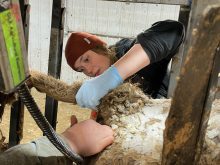HAZEL BLUFF, Alta. — The graphic showing the dramatic spike in electronic cattle auction sales looks like a finger pointing up from a fist.
More than 90,000 head of cattle were sold by electronic auctions in September, up 20,000 from the previous September and 60,000 from September 2011.
It’s a trend that Canfax manager Brian Perillat only sees continuing.
“Generally, the trend is growing to more electronics,” he said.
“It will fluctuate year to year. This year it made a lot of sense and it worked out well.”
Read Also

Feds propose overhaul of chronic wasting disease control program
Chronic Wasting disease control program getting updated by Canadian Food Inspection Agency with feedback encouraged from producers.
Most of the cattle sold through electronic marketing in September were calves or yearlings for October or November delivery through TEAM or DLMS and other electronic auction markets. Cattle producers took advantage of high prices in September without the hassle of rounding up the cattle.
The electronic auctions made up 40 percent of the 248,610 cattle sold in Western Canada in September.
“Prices were phenomenally strong and guys could take ad-vantage of that and still keep their calves out on pasture,” said Perillat.
Scott Letts, a producer from Westlock, Alta., said selling cattle through electronic sales gives control back to the seller.
“If you don’t get your price, or maybe that week the internet sale was weak and buyers were not as aggressive and you say no, the cattle weren’t worked up, they’re still out on pasture,” he said.
“You don’t have to haul them back.”
Letts has sold his yearlings through internet sales for 10 years and has pulled his cattle only once when he felt the price wasn’t high enough.
He spends his time during an electronic auction sale on the phone with the fieldman, closely watching the price.
“The fieldman will tell the auctioneer the seller wants more money so keep pumping these guys,” said Letts.
“That is one reason we do it. They’re not penned up. You haven’t hauled them anywhere. You can decide if they’re going or not going.”
Letts said the fieldman will look at the cattle, take pictures and then make suggestions, such as whether to sell off colour or smaller calves separately or just note them in the sales notes.
“That way the buyers know what is going on.”
Evan Stanley, an order buyer for Jubilee Feedlot in Westlock, said electronic sales offer sellers access to buyers from across Canada and the United States.
“It opens it up to a wide variety of buyers,” said Stanley.
It’s his job, along with the producer, to guess the weight of the cattle while on pasture and what they might weigh in two months when they are delivered.
Most of the time the weight is within 20 to 30 pounds of the predicted weight, and a price slide is built in to account for the higher or lower price.
The buyer and seller looked at the original price, made the adjustments and sold the cattle.
“There is a bit of an unwritten rule that if they are 50 lb. or more out, the buyer has the right to refuse the cattle,” said Stanley.
Guessing the weight and the condition of the grass over the next two months is not easy, he added.
Scott Jeffery of Drayton Valley, Alta., has bought and sold cattle through electronic auctions.
As a seller, his cattle can be seen by all buyers rather than just the ones sitting in the auction market.
As a buyer, it’s easy to acquire even loads of cattle with a complete health history.
“Auction markets are starting to be a thing of the past,” he said.
“There will always be a need for them for odds and ends and smaller producers. For the big producers, they’re probably not very relevant any more.”
Perillat said the shift to more electronic sales is a continuation of a supply chain trend from packers to feedlots and now to cattle producers.















